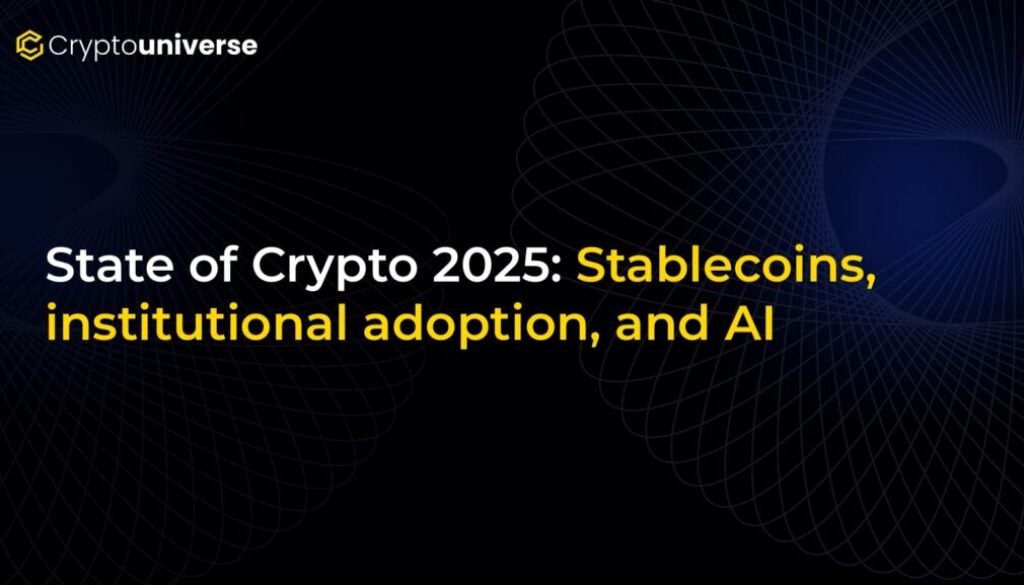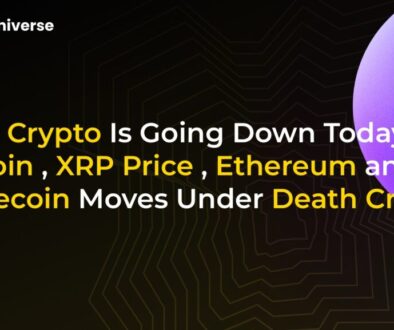State of Crypto 2025: Stablecoins, institutional adoption, and AI

Crypto Has Grown Up: A Look at the Industry’s Transformation in 2025
Just a few years ago, the crypto industry was in its adolescence. Blockchains were slower, more expensive, and the total market was a fraction of what it is today. Fast forward to 2025, and the narrative has fundamentally changed. After weathering market drawdowns and regulatory uncertainty, the builders kept building. The result? A mature, robust industry that is becoming an integral part of the global economy. This is the year the world came onchain.
The story of crypto in 2025 is one of maturation, defined by three seismic shifts: the unstoppable rise of stablecoins, the full-throated embrace of institutional adoption, and the powerful convergence of crypto and AI. Let’s dive into the key findings that paint a picture of an industry that has finally come of age.
Key Metrics at a Glance:
- Total Crypto Market Cap: Crossed the $4 trillion threshold for the first time.
- Bitcoin All-Time High: Surpassed $126,000 as a trusted store of value.
- Active Users: An estimated 40-70 million active onchain users, a significant increase from previous years.
- Total Owners: Over 716 million people now own crypto, but the gap between passive holders and active users presents a massive opportunity for growth.
The Floodgates Open: Institutional Adoption is Here
Perhaps the most significant signal of crypto’s maturity is the arrival of traditional finance (TradFi). What was once a trickle of interest has become a flood of investment and infrastructure development, catalyzed by a more supportive regulatory environment in the United States.
Wall Street Goes Onchain
The passage of bipartisan legislation like the GENIUS Act provided the clarity institutions needed. In response, financial giants have moved decisively.
- Major Banks & Payment Processors: Institutions like JPMorgan, Fidelity, Visa, and Mastercard are now offering crypto products directly to consumers, allowing them to buy, sell, and hold digital assets alongside traditional instruments.
- Fintechs Pave the Way: Companies like Stripe, PayPal, and Robinhood are not just offering access; they are building their own blockchains focused on payments, stablecoins, and tokenized real-world assets (RWAs).
ETPs and Digital Treasuries
Exchange-Traded Products (ETPs) have been a game-changer, unlocking vast pools of institutional capital. With over $175 billion in onchain crypto holdings—a 169% increase from last year—products like BlackRock’s iShares Bitcoin Trust (IBIT) have shattered records. Combined with publicly traded companies holding digital assets on their balance sheets, these institutional vehicles now hold around 10% of both Bitcoin’s and Ethereum’s total supply.
Stablecoins: The Unquestionable Backbone of the Onchain Economy
Nothing demonstrates crypto’s real-world utility better than the explosive growth of stablecoins. Once used primarily for settling speculative trades, they have evolved into the fastest, cheapest, and most efficient way to move U.S. dollars globally—often in under a second for less than a cent.
Transaction Volumes That Rival Global Giants
The numbers are staggering. On an adjusted basis, which filters out bot activity, stablecoins processed $9 trillion in transaction volume over the last 12 months.
- This is more than five times PayPal’s total throughput.
- It’s over half of Visa’s entire network volume.
Crucially, this growth is largely uncorrelated with crypto trading volumes, proving that stablecoins have found true product-market fit for payments, remittances, and other non-speculative use cases.
A New Macroeconomic Force
With a total supply now exceeding $300 billion, stablecoins have become a major force in the global financial system. They are now the #17 largest holder of U.S. Treasuries, surpassing many sovereign nations. As foreign central banks diversify away from U.S. debt, the projected 10x growth of the stablecoin market to $3 trillion by 2030 presents a powerful and sustainable source of demand, unexpectedly strengthening the U.S. dollar’s dominance on a global scale.
The Thriving Onchain World: Beyond the Hype
Underpinning this growth is a wave of innovation across multiple sectors, all made possible by dramatic improvements in blockchain infrastructure. Networks can now process over 3,400 transactions per second—a 100x increase in just five years—at a fraction of the cost.
- High-Performance Chains: Solana has emerged as a leader, powering everything from DePIN projects to NFT marketplaces, while Ethereum continues its scaling journey with Layer-2 solutions like Arbitrum and Base, where transaction costs have fallen to less than a cent.
- DeFi’s Evolution: Decentralized exchanges (DEXs) now account for nearly one-fifth of all spot trading, while perpetuals exchanges like Hyperliquid are generating over $1 billion in annualized revenue.
- Bridging to the Real World: The market for tokenized Real-World Assets (RWAs) like real estate and private credit has quadrupled to $30 billion. Meanwhile, Decentralized Physical Infrastructure (DePIN) projects like Helium are using crypto incentives to build real-world networks for things like 5G coverage.
- NFTs Mature: While market volumes haven’t returned to their 2022 peak, the number of active NFT buyers is growing, signaling a healthy shift from speculation to collecting and utility.
The Next Frontier: The Symbiotic Relationship Between Crypto and AI
As Artificial Intelligence continues its rapid ascent, its inherent challenges of centralization and verification have become clear. Blockchains and crypto offer compelling solutions to AI’s most pressing problems.
A Counterbalance to Centralization
The AI landscape is heavily concentrated. A few tech giants control the vast majority of cloud infrastructure (Amazon, Microsoft, Google) and data center GPUs (NVIDIA). This creates risks of censorship and single points of failure. Blockchains offer a decentralized, transparent, and permissionless alternative for compute, data, and model ownership.
Practical Solutions for an AI-Powered World
- Proof of Humanity: Decentralized identity systems can verify that a user is a human, not a bot, which is critical in an age of AI-generated content.
- An Economy for Agents: Crypto provides the native payment rails for autonomous AI agents to transact with each other, access data, and pay for services without human intermediaries.
- Provenance and IP: Blockchains can create an immutable record of data provenance and intellectual property, ensuring creators and data owners are fairly compensated as their work is used to train AI models.
Conclusion: A New Chapter for the Internet
Seventeen years after its inception, crypto is finally entering adulthood. The infrastructure is fast, cheap, and scalable. The distribution is here, with major financial institutions building onramps for millions. And the regulatory clarity is finally materializing.
The pieces are in place to upgrade our legacy financial systems, rebuild global payment rails, and create a more open, equitable, and user-owned internet. The industry has proven its resilience and is now ready for the mainstream. The next cycle is not just about speculation; it’s about integration.


